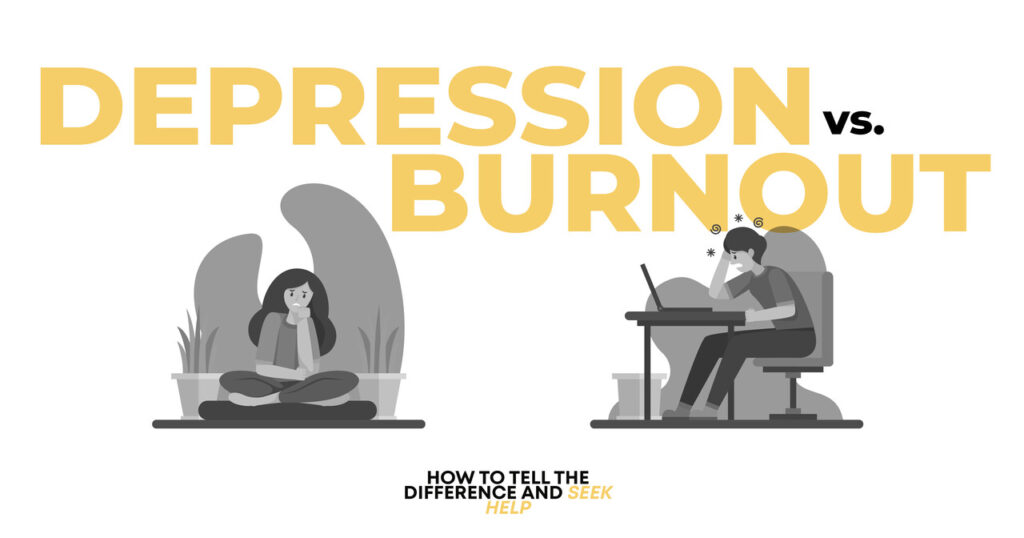Navigating the complex world of mental health can be challenging, especially when it comes to understanding conditions like depression and burnout. Both can deeply affect your well-being and daily life, but they have distinct characteristics and require different treatment approaches. Let’s dive into what sets these two apart and how you can find the help you need.
Essential Takeaways
- Understand the Differences: Depression and burnout have distinct symptoms and triggers. Recognizing these differences is crucial for seeking the appropriate help and treatment.
- Seek Professional Help: If symptoms of depression or burnout persist or affect daily functioning, consult a mental health professional for a proper diagnosis and treatment plan.
- Implement Preventative Measures: Practice stress management, maintain a healthy work-life balance, and engage in self-care to prevent burnout and depression from occurring or recurring.
What is Depression?
Depression is more than just feeling sad or down from time to time. It’s a persistent, often overwhelming mental health condition that can affect every aspect of your life. Major depression is characterized by a variety of depressive symptoms that can lead to severe impairment in daily functioning. Here’s a closer look at what depression is and how it manifests.
Shine Mental Health
Symptoms of Depression
- Persistent Sadness: One of the hallmark symptoms of depression is a pervasive feeling of sadness or emptiness that doesn’t seem to lift. This feeling can persist for weeks or even months, unlike occasional bouts of sadness.
- Feelings of Worthlessness: Persistent feelings of worthlessness, excessive guilt, or self-blame are frequent in depression. These thoughts can be overwhelming and contribute to a negative self-image.
- Loss of Interest: If you’ve lost interest in activities you used to enjoy, it might be a sign of depression. This could include hobbies, social activities, or even work-related tasks.
- Changes in Sleep and Appetite: Depression often impacts your sleep patterns and appetite. You might experience insomnia or sleep excessively, and your eating habits may change—eating too much or too little.
- Fatigue and Lack of Energy: Another common symptom of depression is feeling constantly tired and lacking the energy to complete daily tasks. This isn’t just physical exhaustion; it’s a profound sense of fatigue that affects one’s motivation and ability to function.
- Suicidal Ideation: In severe cases, individuals with depression may experience suicidal thoughts or ideation, which requires immediate intervention from a medical professional. Recognizing these signs is critical for preventing potential harm.
Understanding Burnout
Burnout, often referred to as job burnout or occupational phenomenon, is a state of emotional, physical, and mental exhaustion caused by prolonged and excessive stress, particularly in work-related contexts. Unlike depression, burnout is typically linked to specific stressors and can improve with changes in those stressors.
Symptoms of Burnout
- Emotional Exhaustion: Burnout often manifests as emotional exhaustion, where you feel drained and overwhelmed by the demands placed on you. This is usually tied to work or caregiving responsibilities.
- Reduced Performance: If you’re experiencing burnout, you might notice a decline in your performance and productivity. Tasks that once seemed manageable may now feel insurmountable.
- Detachment and Cynicism: Burnout can lead to feelings of detachment from work or responsibilities and a sense of cynicism or negativity. You might feel disconnected from your job or the people you care for.
- Physical Symptoms: Burnout often comes with physical symptoms such as headaches, gastrointestinal issues, or frequent illnesses. These symptoms are related to the chronic stress your body is under.
- Feelings of Emptiness and Hopelessness: Individuals experiencing burnout may also report feelings of emptiness or hopelessness, similar to those in depression, highlighting the overlap between these two conditions.
Key Differences Between Depression and Burnout
While depression and burnout can share some symptoms, they have distinct characteristics and triggers. Understanding these key differences is crucial for seeking the right help and treatment.
Symptoms of Depression vs. Burnout
- Depression typically involves a pervasive sense of sadness, loss of interest in activities, and feelings of worthlessness, affecting multiple areas of life. It’s not necessarily tied to a specific cause and can be present even without apparent stressors.
- Burnout, on the other hand, is often directly related to work or caregiving stressors. It manifests as emotional exhaustion, detachment, and reduced performance and is clearly connected to the stressors causing it.
Duration and Triggers
- Depression can be long-lasting, with symptoms persisting for weeks, months, or even years if left untreated. It’s often a result of a combination of genetic, biological, and environmental factors rather than a single identifiable cause.
- Burnout is typically related to specific stressors and can improve with changes in those stressors, such as reducing work hours or seeking support. The duration of burnout varies depending on how effectively the underlying stressors are addressed.
Risk Factors for Depression and Burnout
Understanding the risk factors for both conditions can help in early identification and prevention.
Common Risk Factors for Depression
- Genetic Predisposition: A family history of depressive disorders can increase your risk of developing depression.
- Medical Conditions: Chronic medical illnesses, such as diabetes or heart disease, can contribute to feelings of hopelessness and depression.
- Affective Disorders: Individuals with a history of affective disorders, such as bipolar disorder, are more likely to experience depression.
Common Risk Factors for Burnout
- Occupational Stress: High levels of work-related stress can lead to burnout, particularly in demanding jobs with little support.
- Job Dissatisfaction: Feeling unfulfilled or dissatisfied in your job can contribute to feelings of burnout.
- Chronic Stress: Unrelenting pressure, whether at work or in personal life, can lead to burnout over time.
How to Recognize the Signs
Recognizing the signs of depression and burnout is the first step toward getting the help you need. Self-assessment tools can be helpful in identifying symptoms, but professional evaluation is crucial for an accurate diagnosis.
Shine Mental Health
Self-Assessment Tools
Various self-assessment tools available online can help you gauge your symptoms. These include questionnaires and scales designed to assess the severity of depression or burnout. While these tools can provide insight, they should not replace professional evaluation.
Examples of Self-Assessment Tools:
- Maslach Burnout Inventory (MBI): A widely used tool to assess the severity of burnout, focusing on emotional exhaustion, depersonalization, and reduced personal accomplishment.
- Sydney Burnout Measure: Another effective measure for evaluating burnout symptoms, offering insights into emotional exhaustion and feelings of inefficacy.
When to Seek Professional Help
Knowing when to seek professional help is vital. If your symptoms are persistent, severe, or affecting your ability to function daily, it’s time to consult a mental health professional.
Signs You Should Seek Help:
- Persistent Symptoms: If symptoms of depression or burnout don’t improve with time or self-help measures.
- Interference with Daily Life: When symptoms impact your ability to work, maintain relationships, or perform daily tasks.
- Co-occurring Issues: If you’re experiencing other mental health issues alongside depression or burnout, such as anxiety disorders or substance abuse.
Treatment and Management Strategies
Effective treatment and management strategies depend on whether you’re dealing with depression, burnout, or both. Here’s a breakdown of how to approach treatment for each condition.
Treatment Options for Depression
- Psychotherapy: Cognitive Behavioral Therapy (CBT) and other therapeutic approaches can help address negative thought patterns and develop coping strategies. Therapy can be a crucial component in managing and overcoming depression.
- Medications: Antidepressants such as SSRIs (Selective Serotonin Reuptake Inhibitors) and SNRIs (Serotonin-Norepinephrine Reuptake Inhibitors) can be effective in managing depression. It’s essential to work with a health care professional to find the right medication and dosage.
- Lifestyle Changes: Incorporating regular exercise, a balanced diet, and good sleep hygiene can significantly impact your mood and overall well-being. Mindfulness practices and stress management techniques can also be beneficial.
Strategies for Managing Burnout
- Set Boundaries: One of the most effective ways to manage burnout is to set clear boundaries between work and personal life. This can include limiting overtime, taking regular breaks, and ensuring time for relaxation and self-care.
- Seek Support: Talking to a supervisor, HR, or a counselor about your workload and stressors can help. Adjustments can be made to reduce stress and improve work conditions.
- Incorporate Self-Care: Engage in activities that help you unwind and relax, such as hobbies, exercise, or spending time with loved ones. Self-care is essential for replenishing your emotional and physical energy.
Combining Approaches for Best Results
For individuals experiencing both depression and burnout, a combined approach to treatment is often necessary. This might involve therapy and medication for depression, alongside strategies for managing work-related stress and setting boundaries to address burnout.
Support Systems and Resources
Building a support system and accessing resources can be incredibly beneficial in managing both depression and burnout.
- Therapy and Counseling: Seek help from mental health professionals who can provide tailored support and guidance.
- Support Groups: Join support groups where you can share experiences and learn from others facing similar challenges.
- Online Resources: Numerous online resources and hotlines can offer immediate support and information on mental health conditions.
Conclusion
Understanding the differences between depression and burnout is essential for seeking the appropriate help. By recognizing the signs, understanding the symptoms, and exploring treatment options, you can take proactive steps toward improving your mental health. Remember, it’s okay to seek help and prioritize your well-being. You deserve support and a path to recovery that leads to a fulfilling life.
Shine Mental Health
FAQs
- What are the main symptoms of depression?
- Persistent sadness, loss of interest in activities, changes in sleep and appetite, fatigue, and feelings of worthlessness or guilt.
- How can I tell if I’m experiencing burnout or depression?
- Depression typically involves a pervasive sense of sadness and impacts multiple areas of life. At the same time, burnout is often linked to work or caregiving stress and is characterized by emotional exhaustion and reduced performance.
- When should I seek professional help for burnout or depression?
- Seek professional help if symptoms are persistent, severe, or interfering with your ability to function daily or if you’re experiencing other mental health issues alongside these conditions.
- What treatment options are available for depression?
- Treatment options include psychotherapy (e.g., Cognitive Behavioral Therapy), medications (e.g., SSRIs, SNRIs), and lifestyle changes (e.g., exercise, diet).
- How can I support a loved one who is experiencing burnout or depression?
- Offer a listening ear, encourage them to seek professional help, support their self-care efforts, and help them find resources and support groups.







